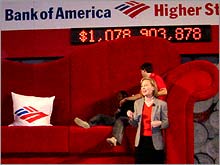 |
| Bank of America planted a giant couch in New York's Grand Central Station to symbolize how loose change can add up to savings. |
|
|
|
NEW YORK (CNN/Money) -
It's a lesson most children learn from their parents: a penny saved is a penny earned. Now banks are shaking up that notion by telling consumers that a dollar spent could lead to a penny saved.
It may seem like a mind boggling concept but an increasing number of financial institutions, citing abysmal rates of savings among Americans, are launching spend-to-save credit cards and debit cards, aimed at helping consumers to pad their savings accounts even as they open their wallets.
But will these products truly place consumers on the road to savings nirvana or will they simply encourage already spend-happy Americans to spend more?
Earlier this month both Bank of America (Research) and American Express (Research) launched spend-to-save programs. EmigrantDirect, the online branch of New York-based Emigrant Savings Bank, will launch a new credit card in mid-November that the company said will have the "highest cash-back rebate in the country" for those with online high-yield accounts.
The pitch sounds appealing. Bank of America, through its "Keep the Change" program allows its debit card users to round up the price of any expenditure to the next dollar and place the difference in a savings account. The company will then match that figure by 100 percent for the first three months and 5 percent after that up to $250.
American Express is offering a credit card with a twist. Through the "One" program, American Express will deposit one percent of customer spending into a high-yield savings account – currently at a rate of 3.15 percent – every month and consumers can contribute extra funds to their account directly from their separate checking, savings or brokerage accounts.
Both companies said the products aren't aimed at changing consumer behavior towards spending but rather will help consumers to save money on every dollar they do spend.
"Consumers are going to spend anyway," said Simran Kalra, vice president of cards at American Express. "Through the One card, a full one percent of customer spending will be put into a high-yield savings account and that certainly adds up."
Spend-to-save draws criticism
But critics worry that relying on credit cards and debit cards as a tool towards savings is counter-intuitive.
"You can't spend your way into savings just like you can't borrow your way out of debt," said Todd Mark, spokesperson for Consumer Credit Counseling of Greater Atlanta. "If you're a consumer that's not saving in any other way, this is the least you should be doing."
Recent government data indicates that consumers may need all the help they can get. The U.S. Department of Commerce reported in August that Americans have a zero-rate of savings and consumer spending actually climbed by one percent as Americans continue to spend more than they earn.
Still, Mark added that, in the long run, the savings from these products are fairly minimal. Bank of America estimates consumers will save $150 to $250 a year through the "Keep the Change" program – not counting standard fees associated with savings account – and for the One card, credit card users can expect only $1 back for every $100 they spend. If they carry a balance, tack on balance charges and after the first year, there is a $35 annual fee on the card.
But Bank of America senior vice president of Deposits and Debit Products Diane Morais said the company's program isn't designed to replace traditional savings methods but rather serve as an automatic method of bolstering whatever savings they may have.
"Like the infamous change you put on the dresser, when you go back and count it, it's surprising how much you saved over time," she said.
Weighing debit and credit card programs
And consumer advocates do see a difference between using a debit card that relies on the funds you have in your account and a credit card, which is essentially borrowed funds.
Assuming there are no hidden fees, Travis Plunkett, legislative director of Consumer Federation of America, said a debit card program can be a positive addition for consumers as long as they don't replace or forgo savings programs such as a 401(k) or IRA with their debit-linked savings. He said consumers are more likely to save if it's automatic and as long as the funds come out of the person's checking account, it can be a "healthy small step towards saving."
But he was less enthusiastic about using credit to save.
"To encourage people to take on more debt as a way of saving money could increase the problem of significant indebtedness in this country," he said. "It seems more like a clever marketing ploy than a legitimate method of increasing savings."
And J. Craig Shearman, spokesman for the National Retail Federation, warned that while financial institutions may look generous by adding money to match the savings in the account, in reality those companies make up the revenue by charging merchants higher interchange fees for each purchase.
Interchange fees can vary from 25 cents to a full 2 percent of the purchase price. While it seems like a small amount, Shearman said those merchant fees to credit card companies add up to $25 billion a year– a figure that merchants pass on to consumers through higher prices.
"These programs look very simple and appealing on the surface until you start to examine the details," he said. "Consumers are ultimately paying the price."
---------------------------------------------------------------
Are online savings account a better option for consumers? Find out here.

|